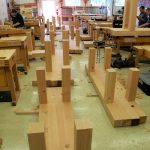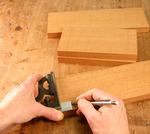We may receive a commission when you use our affiliate links. However, this does not impact our recommendations.
 Having recently received a few questions concerning backsaws, I’ve decided to open up the archives and give you an article Christopher Schwarz, contributing editor, wrote for the Spring 2008 issue of Woodworking Magazine: “Understanding Western Backsaws.” Therein, he explains the size, tooth configurations and raison d’etre of four saws: the dovetail saw; the carcase saw; the tenon saw; and the sash saw. Plus, you’ll find Chris’s thoughts on halfback saws.
Having recently received a few questions concerning backsaws, I’ve decided to open up the archives and give you an article Christopher Schwarz, contributing editor, wrote for the Spring 2008 issue of Woodworking Magazine: “Understanding Western Backsaws.” Therein, he explains the size, tooth configurations and raison d’etre of four saws: the dovetail saw; the carcase saw; the tenon saw; and the sash saw. Plus, you’ll find Chris’s thoughts on halfback saws.
Also below, you’ll find a PDF of Charles Holtzapffel’s chart with the specs of various saws – including some now-obscure tools (anyone have a “Comb cutter’s saw?” I’d love to see it!). The chart, titled “Table of the Dimensions of Rectilinear Saws,” is from his 1846 book “Construction, Action and Application of Cutting Tools.”
Click to download Chris’s article: WesternBacksaws.pdf
Click to download Holtzapffel’s Saw Chart: holtz_saw_table.pdf
Need more on saws and sawing? Get Christopher Schwarz’s “Sawing Fundamentals,” a set of two DVDs he recorded for Lie-Nielsen Toolworks, or his “Build a Sawbench” DVD (Popular Woodworking Books) – build one of these, and you’ll not only get a crash course in sawing, but you’ll have a traditional sawing surface when you’re done (and I have it on good authority that a sawbench also serves well as a cat perch).
Here are some supplies and tools we find essential in our everyday work around the shop. We may receive a commission from sales referred by our links; however, we have carefully selected these products for their usefulness and quality.










Yes she is! And thanks for the links.
Well guys, I guess Megan isn’t coming back by to read our comments.
Thank you for the download links Megan, and pointing out the Holtzapffel book. I see the paper back is selling for $20-$25. One seller is selling one new, still in the original shrink wrap, for $25. Of course the paper back version was printed in 1993.
Hm, I don’t have a comb cutter’s saw (thanks for the pic, Dean), but I see that pruning saw is on the list and I have one of those; a York State Pruner by Disston. I have yet to sharpen it and take after the ol’ apple tree though. It looks like a fairly normal handsaw; 20″ long, 7ppi, narrow toe, and thick sawplate. There were/are other forms of pruning saws though, of course.
So far I’ve only found one picture (drawing) for a “comb cutter’s saw” (see link below). It’s the 6th picture from the bottom of the page, or you can do a find on one of these two strings “comb tooth saw” or “double-edged”. There is a short description also. Maybe someone else can find a better image for you.
I also found this definition in the “Encyclopedic Dictionary”, Vol. II, Part I – published 1882. I didn’t include the URL since it is very long, and I could not embed the address. I did save the URL if you are interested. You can download it as a pdf if you want.
“Comb Saw, s. The hand-saw of the comb-cutter is called a stadda, and has two blades, one deeper than the other; a gauge on the saw-blade determines the depth of cut. Some of the saws are serrated on each edge. The blades are made of thick steel, and are ground away on the edges as thin as the notches of the comb. They have about twenty points to the inch. Between the blades is a thin slip or tongue of metal, called a languet, which determines and preserves the interval. (Knight.)”
http://www.angelfire.com/mi4/olafvanta/Dirk/comb/combstruction.htm
I have to say, I love Popular Woodworking Magazine! So few magazines will give away articles, even older ones like this. You could have easily provided a link to the back issue buy. It truly shows Popular Woodworking’s mission to educate and help woodworkers.
Mike